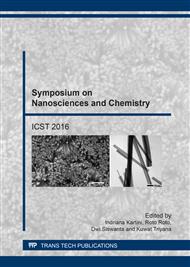[1]
Wells GB, Dipiro JT, Schwinghammer TL, Dipiro CV. Pharmacotherapy, 7th ed. McGraw-Hill New York, (2009).
Google Scholar
[2]
Kim SH, Hyun SH, and Choung SY. Anti-diabetic effect of Cinnamon extracts on blood glucose in db/db mice. J. Eth. Pharm. 104(2006)119-122.
DOI: 10.1016/j.jep.2005.08.059
Google Scholar
[3]
Lam S, Chen J, Kang C, Lee S. α-Glucosidase inhibitors from the seeds of Syagrus romanzoffiana. J. Phytochem. 69(2008)1173-1181.
DOI: 10.1016/j.phytochem.2007.12.004
Google Scholar
[4]
Mayfield J. Diagnosis and classification of diabetes mellitus: New Criteria. Am. Fam. Physician 58(1998) 1355-1357.
Google Scholar
[5]
Herfindal ET, Gourley DR. Therapeutics, drug, and disease management, 7th ed. Baltimore, Maryland; 2000. pp.377-406.
Google Scholar
[6]
Shinde J, Taldone T, Barlette M, Kunaparaju N, Hu B, Kumar S, Placido J, Zito SW. α-Glucosidase inhibitory activity of Syzygium cumini (Linn. ), skeels seed kernel in vitro and in Goto-Kakizaki (GK) rats. J. Chem. Educ. 343(2008) 1278-1279.
DOI: 10.1016/j.carres.2008.03.003
Google Scholar
[7]
Nampoothiri SV, Prathapan A, Cherian LO, Raghu KG, Venugopalan VV, Sundaresan A. In vitro antioxidant and inhibitory potential of Terminalia bellerica and Emblica officinalis fruits against oxidation and enzymes linked to type 2 diabetes. Food. Chem. Toxicol. 49(2011).
DOI: 10.1016/j.fct.2010.10.006
Google Scholar
[8]
Ren S, Duoduo X, Zhi P, Qipin G. Two flavonone compounds from litchi (Litchi chinensis Sonn), seeds, one previously unreported, and appraisal of their α-glucosidase inhibitory activities. Food Chem. 127(2011) 1760-1763.
DOI: 10.1016/j.foodchem.2011.02.054
Google Scholar
[9]
Lee SL, Huang WJ, Lin WW, Lee SS, Chen CH. Preparation and anti-inflammatory activities of diarylheptanoid and diarylheptylamine analogs. Bioorg. Med. Chem. 13(2005)1643-1678.
DOI: 10.1016/j.bmc.2005.06.058
Google Scholar
[10]
Babu PS, Prabuseenivasan S, Ignacimuthu S. Cinnamaldehyde—A potential antidiabetic agent. J. Phytomed. 14(2007) 15-17.
DOI: 10.1016/j.phymed.2006.11.005
Google Scholar
[11]
Allen RW, Schwartzman E, Baker WL, Coleman CI, Phung OJ. Cinnamon use in type 2 diabetes: An updated systematic review and meta-analysis. Ann. Fam. Med. 11(2013) 452-461.
DOI: 10.1370/afm.1517
Google Scholar
[12]
Lekshmi PC, Arimboor R, Indulekha PS, Menon AN. Turmeric (Curcuma longa L. ) volatile oil inhibits key enzymes linked to type 2 diabetes. J. Food Sci. Nutr. 63(2012) 832-836.
DOI: 10.3109/09637486.2011.607156
Google Scholar
[13]
Eryanti Y, Narulita Y, Hendra R, Yuharmen, Jufrizal S, Adel Z. Synthesizing derivatives from cyclopentanone analogue curcumin and their toxic, antioxidant, and anti-inflammatory activities. Makara Sains 15(2011) 117-120.
DOI: 10.7454/mss.v15i2.1060
Google Scholar
[14]
Yuan X, Li H, Bai H, Su Z, Xiang Q, Wang C, Zhao B, Zhang B, Zhang Y, Zhang Q, Chu Y, Huang Y. Synthesis of novel curcumin analogues for inhibition of 11β-hydroxysteroid dehydrogenase type 1 with anti-diabetic properties. Eur. J. Med. Chem. 77(2014).
DOI: 10.1016/j.ejmech.2014.03.012
Google Scholar
[15]
Pavia DL, Lampman GM, Kriz GS. Introduction to spectroscopy. Brooks/Cole Thomson learning, New York; (2001).
Google Scholar
[16]
Zhiyun D, Rongrong L, Weiyan S, Xuepu M, Lin M, Lianquan G, Zhishu H, Albert SCC. α-Glucosidase inhibition of natural curcuminoids and curcumin analogs. Eur. J. Med. Chem. 41(2006)213-218.
Google Scholar
[17]
Kumar S, Narwal S, Kumar V, Prakash O. α-Glucosidase inhibitors from plants: a natural approach to treat diabetes. Pharmacol. Rev. 20(2011).
DOI: 10.4103/0973-7847.79096
Google Scholar
[18]
Vessal M., Hemati M., Vasei, M. Antidiabetic effect of quercetin in streptozocin-induced diabetic rats. Comp. Biochem. Physiol. Toxicol. Pharmacol. 135(2003) 357-361.
DOI: 10.1016/s1532-0456(03)00140-6
Google Scholar
[19]
Annapurna HV, Apoorva B, Ravichandran N, Arun KP, Brindha P, Swaminathan S, Vijayalakshmi M, Nagarajan A. Isolation and in silico evaluation of antidiabetic molecules of Cynodon dactylon (L. ). J. Mol. Graph Modell. 39(2013) 87-94.
DOI: 10.1016/j.jmgm.2012.10.009
Google Scholar


